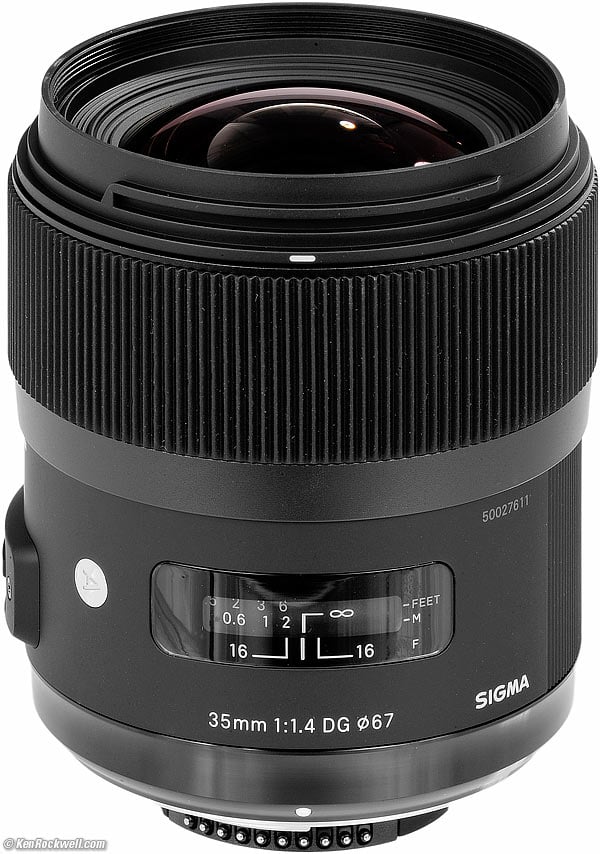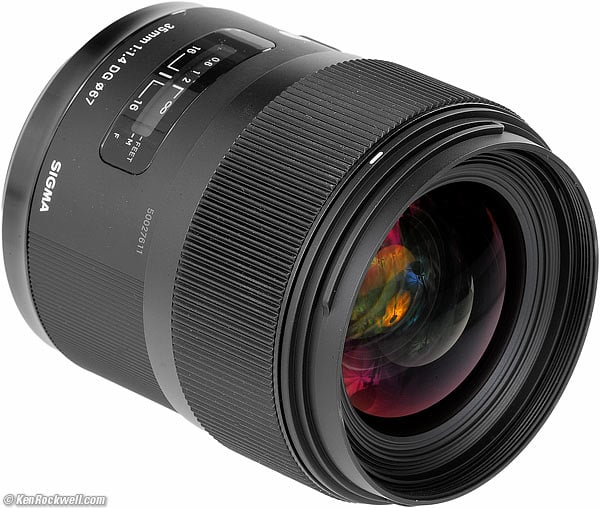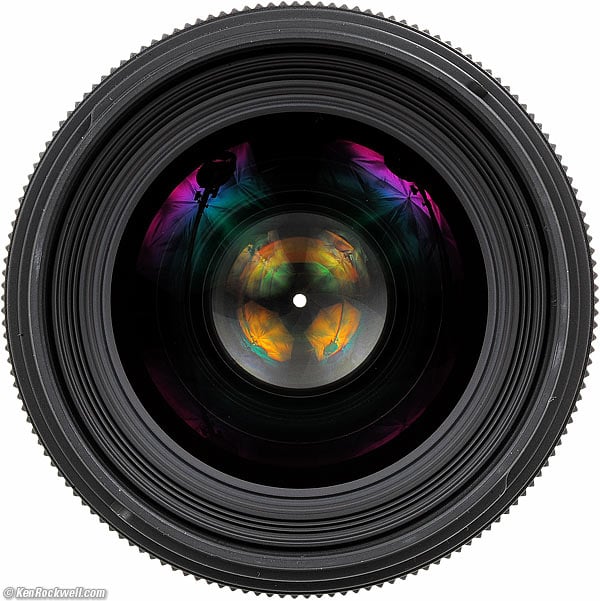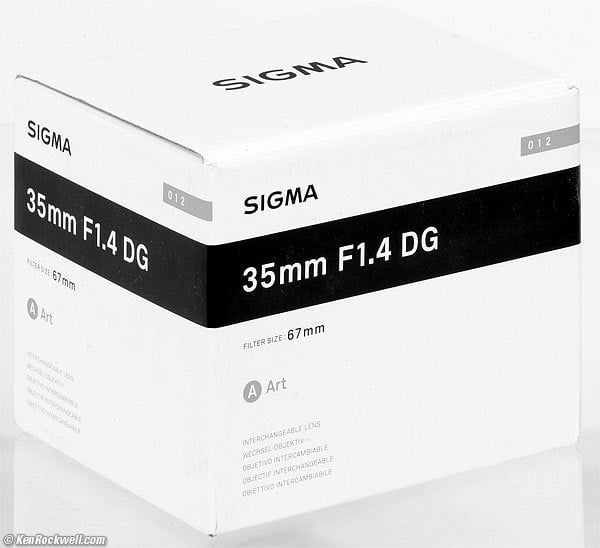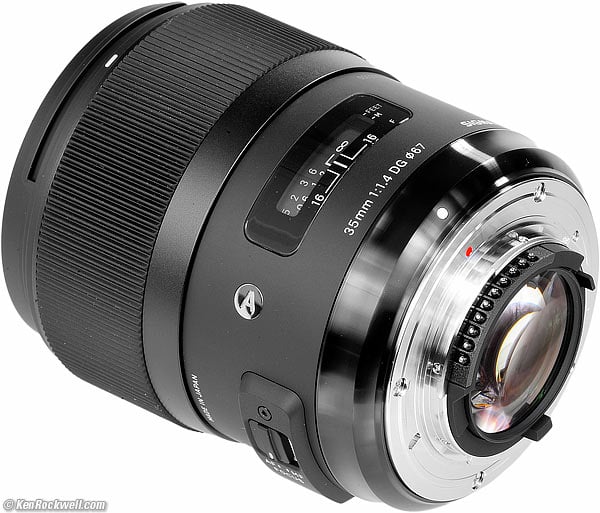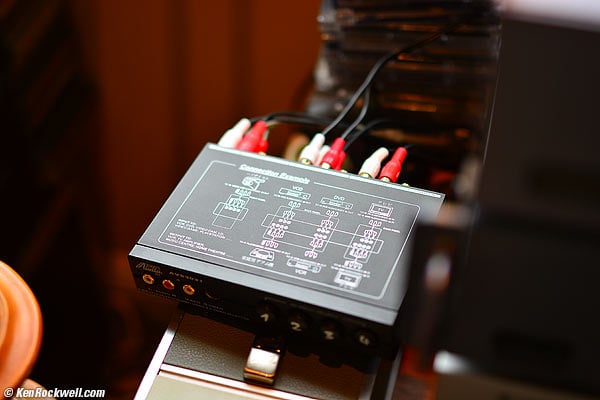Home Donate New Search Gallery Reviews How-To Books Links Workshops About Contact
Sigma 35mm f/1.4
Full-Frame DG HSM Art (2012-)
© 2013 KenRockwell.com. All rights reserved.
Intro Specifications Performance Compared Recommendations More
Sigma 35mm f/1.4 DG HSM, Nikon version (FX, Full-Frame, DX and 35mm coverage, 67mm filters, 23.3 oz./661g, 1'/0.3m close focus, about $900. Also comes in Canon EOS, Sony, Minolta Maxxum, Pentax and Sigma mounts, ). enlarge. The biggest source of support for this free website is when you use these links, especially this link directly to this lens at Adorama and this link to it at Amazon, when you get anything, regardless of the country in which you live. It helps me keep adding to this free website when you get yours through these links — but I receive nothing for my efforts if you buy elsewhere. Thanks for your support! Ken.
June 2013 Sigma reviews Nikon Canon LEICA Pentax Sony
Why Fixed Lenses Take Better Pictures
Nikon 35mm f/1.4 G Review (2010-today)
Nikon 35mm f/1.4 AI-s Review (1981-today)
Canon EF 35mm f/1.4 L (1998-today)
Introduction top
Intro Specifications Performance Compared Recommendations More
|
Adorama pays top dollar for your used gear. I use these stores and ScanCafe. I can't vouch for ads below.
|
The Sigma 35mm f/1.4 is an optically excellent lens in a merely consumer-grade package. Since all the other 35mm f/1.4 lenses are fully professional lenses, of course this Sigma costs less.
This Sigma is as good optically as the Canon EF 35mm f/1.4 L and Nikon 35mm f/1.4 G, but its mechanics seem to be the poorest of any other 35mm f/1.4 lens I've ever seen.
Do not use this lens on Nikon DX cameras simply because the Nikon 35mm f/1.8 DX is as good optically, better mechanically and compatibility wise, and is smaller, lighter and less expensive. You have to pay a lot more for a full-frame lens' coverage, which is then wasted on a DX camera. Canon has no inexpensive, high performance 35mm f/1.4 or f/1.8 lenses; however I'd buy a less expensive and slower (but higher mechanical quality) Canon 35mm f/2 or 40mm f2.8 long before I soiled my bag with Sigma.
Some of my older Sigma lenses won't work on my newest cameras, while my older Nikon, Canon and LEICA lenses work great on today's newest cameras. With only a one-year warranty, buy this Sigma lens for great photos today, but I don't consider it a wise investment for the future. Unlike digital cameras which are thrown away after a few years, I always buy my lenses as long-term investments, which is why I wouldn't buy this Sigma lens — but if all you care about is great photos today, don't let me stop you.
The only reason for this lens is price, not quality. If you shoot Canon, the Canon EF 35mm f/1.4 L (about $1,260 after you add it to your online shopping cart) is a huge bargain. It's a proven, fully professional lens far better made than this Sigma, and not much more expensive. If you shoot Canon, get the Canon lens and you'll never look back; the quality is remembered long after the price is forgotten. The Canon L lens is all-metal, and optically superb as well. This Sigma is nowhere near L quality mechanically.
If you shoot Nikon, the classic Nikon 35mm f/1.4 AI-s ($850 new or $500 used) is better made than any of these — and less expensive to boot, but as the oldest isn't quite as good optically wide-open as the rest. The Nikon 35mm f/1.4 AI-s is a professional manual-focus lens. It's still made today, but not well known outside professional circles.
The new autofocus Nikon 35mm f/1.4 G ($1,620) is a completely different lens, and is optically superb. It's also the next poorest-made lens of all, with lots of plastic. It's the only other 35mm f/1.4 with a plastic filter thread, and costs double the price of this Sigma.
For Nikon, if you only think short-term, sure, get this Sigma lens, but if you think long-term and realize that the lenses you buy today should serve you well for at least the next 10 to 20 years, I'd go for the Nikon — which has a 5-year warranty, too.
As the ancient proverb so correctly observes, "the poor man always pays twice." He pays once to get something cheap, and then again pays full price for what really wanted in the first place when the cheap thing breaks. How do the rich get richer? By always buying quality. I'd much rather have a used Nikon or Canon 35/1.4 than this Sigma.
This Sigma has slightly less distortion than the Canon and Nikon lenses, and focuses a bit more accurately at f/1.4 than did the Nikon 35/1.4G, and it's as super-sharp as the Canon and Nikon pro lenses, so if you're a risk taker, sure, go get one of these consumer-level Sigmas if you're considering it. Its optics are first-rate.
WARNING
Nikon and Canon don't give away developer kits to their competition (like Sigma) to make lenses that work with Nikon and Canon cameras. No one knows their secret sauces to ensure compatibility, especially with unreleased cameras coming in the future.
Nikon and Canon know what's next, so their lenses today will work with cameras tomorrow. Sigma doesn't. When you buy off-brands, even if it works perfectly today, there's no guarantee that anything will work with the next camera you buy tomorrow.
My suggestions below are only guesses that relate to how well a camera-brand lens with similar technology will work with various cameras. Your actual luck with this lens may be worse.
I actually tried this Sigma on my Nikon D800E and Nikon D7100 and it works great.
I tried it on my Nikon F4, and it sort of worked, except that the finder displays extinguished each time it got focus and I held down the shutter halfway. I don't know if its simply a weirdness that's merely an inconvenience (exposures seemed like they were probably OK), or if something about this Sigma lens is going to damage my F4 with continued use. Buyer beware.
Everything is supposed to work perfectly on every digital Nikon ever made, both FX and DX, from the best D4, D800, D800E and D600 to Nikon's cheapest digitals like the D40, D40x, D60, D3000, D3100, D3200, D5000, D5100 and D5200.
It's supposed to work on decent or recent AF film cameras like the F6, F100, F5, N80 and N75.
The incompatibilities if everything works as well as a real Nikon lens for older or cheaper 35mm cameras are that:
1.) It won't autofocus with the cheapest new AF 35mm cameras like the N55, but if you focus manually, everything else works great. Even if you lose autofocus, these cameras have in-finder focus confirmation dots to help you.
2.) Late 1980s ~ early 1990s AF cameras like the N90s, N70 and F4 will focus just fine, but you'll lose VR. You'll have Program and Shutter-priority modes, but lose Manual and Aperture-priority since you have no way to set the aperture on the camera or on the lens.
3.) You're really pushing it with the oldest AF cameras like the N2020, N6006 and N8008. You'll have no AF, confused exposure modes, and no VR. Manual focus is fine, along with electronic focus indications.
4.) Since it has no aperture ring, it's just about useless with manual focus film cameras. It will shoot every shot at its minimum aperture.
See Nikon Lens Compatibility for details with your camera. Read down the "AF-S," "G" and "VR" columns for this lens. You'll get the least of all the features displayed in all columns, since "G" (gelding) is a deliberate handicap which removes features. Remember, when you put mud brand lenses on your Nikon, all bets are off.
The Canon version ought to be compatible with every Canon EOS camera. I haven't tried it. EOS cameras are every Canon 35mm autofocus SLR and digital DSLR camera made since the Canon EOS 650 of 1987.
Sigma 35mm f/1.4 DG HSM. enlarge.
Specifications top
Intro Specifications Performance Compared Recommendations More
Name top
Sigma calls this the Sigma 35mm F1.4 DG HSM | A.
DG: Marketing fluff, means it also works on the new "digital" cameras.
HSM: "Hypersonic" autofocus Motor, a copy of Canon's USM (UltraSonic Motor) and Nikon's copy of Canon's USM, the Nikon SWM (Silent Wave Motor).
A: "Art" series, just marketing BS.
Also has, but not listed
G: Gelded for cost-reduction and removing compatibility with older Nikons.
Aspherical: Specially-shaped glass for greater sharpness at f/1.4.
Optics top
13 elements in 11 groups.
Two are aspherical.
One is FLD and two are SLD, which is magic glass similar to Nikon's ED and Canon's UD glass.
Multicoated.
Rear-focusing. Nothing moves externally as focused.
Diaphragm top
Sigma 35mm f/1.4 DG HSM at f/XX. enlarge.
9 rounded blades.
Stops down to f/16.
Coverage top
35mm film, Full-Frame, FX and DX.
Focal Length top
35mm.
When used on a DX camera, it sees an angle of view similar to what a 50 mm lens sees when used on an FX or 35mm camera.
When used on a Canon 1.6x (APS-C), it sees an angle of view similar to what a 56 mm lens sees when used on an FX or 35mm camera.
Angle of View top
63.4° diagonally on Full-Frame, FX digital and 35mm.
Close Focus top
1 foot (0.3 meters) from the image plane.
Maximum Reproduction Ratio top
1:5.2.
Hard Infinity Focus Stop? top
No.
You have to let the AF system focus at infinity.
Focus Scale top
Yes, abbreviated.
Depth-of-Field Scale top
Yes, abbreviated.
Infra-Red Focus Index top
No.
Aperture Ring top
No.
Filter Thread top
67 mm, plastic.
Does not move.
Size top
Sigma specifies 3.0" (77 mm) diameter by 3.7" (94 mm) extension from flange.
Weight top
23.300 oz. (660.6 g), actual measured.
Sigma specifies 23.5 oz. (665 g).
Hood top
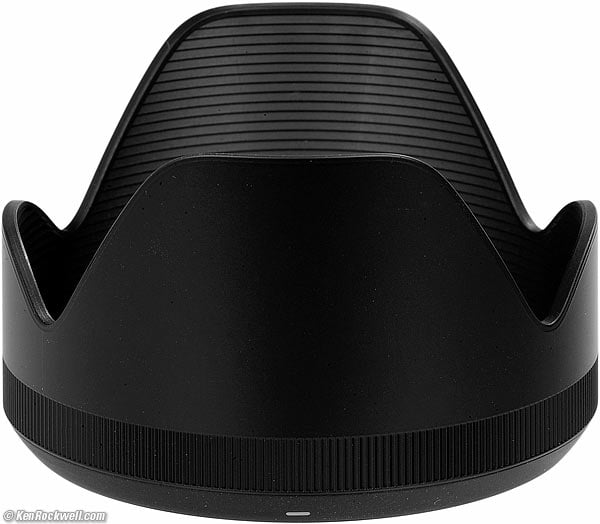
LH-730-03 Hood, Sigma 35mm f/1.4 DG HSM.
Plastic LH-730-03 bayonet hood, included.
Case top
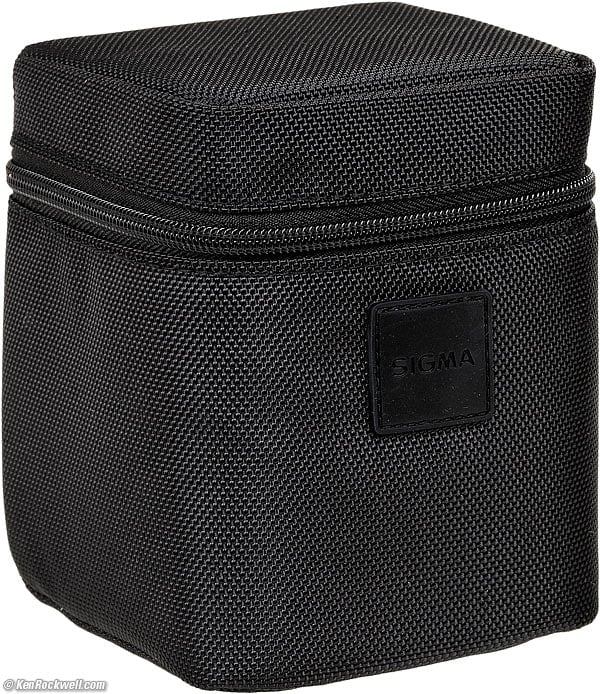
Case, Sigma 35mm f/1.4 DG HSM.
Nice padded nylon case included.
Included top
Lens caps.
Hood.
Case.
Paperwork.
Made in top
Japan.
Warranty top
1 year, Americas.
Possibly longer warranties in various countries.
Packaging top
White cardboard box.
Box, Sigma 35mm f/1.4 DG HSM. enlarge.
In this box sits the lens inside a plastic bag which sits with the hood inside the case. The case is the padding - there is no foam.
Announced top
Photokina, September 2012.
Price, USA top
September 2012-April 2013: $900.
Performance top
Intro Specifications Performance Compared Recommendations More
Overall Autofocus Bokeh Color Coma
Distortion Ergonomics Falloff Filters
Focus Breathing Ghosts Hood Lateral Color Fringes
Macro Mechanics Sharpness Spherochromatism Sunstars
Overall performance top
The Sigma 35mm f/1.4 DG HSM has fantastic optics — as good as the Canon EF 35mm f/1.4 L and Nikon 35mm f/1.4 G, and with less distortion — but its mechanics and potential camera incompatibility are why you pay less than for the professional Nikon or Canon lenses.
Autofocus performance top
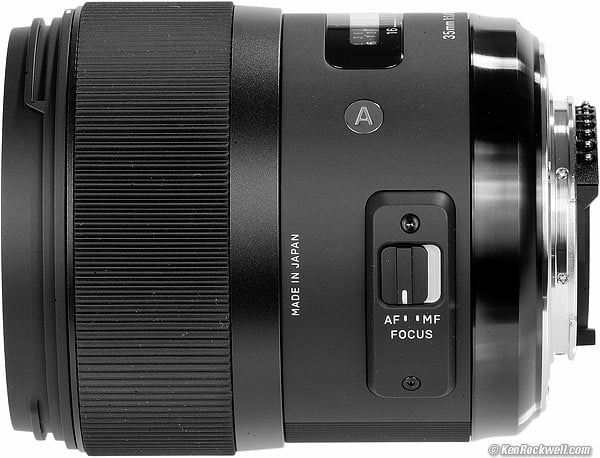
AF/MF Switch, Sigma 35mm f/1.4 DG HSM.
Overall
AF works fine on my Nikon D800E, D7100 and Nikon F4.
It's fast enough and super-accurate so that I can take advantage of this lens' great sharpness at f/1.4 — which is actually better than I observed with the Nikon 35mm f/1.4 G!
AF Speed
AF speed is reasonably fast, especially considering that faster lenses need to be more precise, and are therefore slower, than slower lenses.
AF Accuracy
On my Nikon D800E, AF was dead-on for every frame, especially shot at f/1.4 where this is critical.
Manual Focus
Manual focus is swell, just grab the ring.
Manual Focus Override
Manual focus override works, but not always as you'd expect from a real Nikon or Canon lens.
On my Nikon D7100 in AF-A mode, even on still subjects it wouldn't lock, and the D7100 kept hunting and grabbing focus away from me as I tried to set a manual override. To get this to work on my Nikon, I had to force the Nikon to AF-S and wait for it to lock, only after which could I then use the manual focus ring without my camera continuing to try to autofocus.
Bokeh performance top
Bokeh, the character of out of focus backgrounds, is pretty good. Backgrounds never distract.
Color Rendition performance top
The color rendition seems about the same as my Nikkor AF lenses.
Coma performance top
Coma (saggital coma flare) often causes weird smeared blobs to appear around bright points of light in the corners of fast or wide lenses at large apertures. In lenses that have it, coma goes away as stopped down.
I saw no coma with this aspherical lens.
Distortion performance top
The Sigma 35mm f/1.4 DG HSM has no visible distortion at moderate focus distances around 3 to 10 feet (1 to 3 meters). It has minor barrel distortion at infinity and strong barrel distortion down at only 1 foot (30 cm).
No Nikon or Canon camera will be able to correct this automatically, as many of these cameras can do for their own-brand lenses today.
More good news is that what distortion there is can be corrected completely for critical use by plugging these figures into Photoshop's lens distortion filter. These aren't facts or specifications, they are the results of my research that requires hours of photography and calculations on the resulting data.
On FX, Full-Frame and 35mm Film |
|
∞ |
+1.1 |
10' (3m) |
+0.3 |
3' (1m) |
+0.6 |
1' (0.3m) |
+2.3 |
© 2013 KenRockwell.com. All rights reserved.
Ergonomics (handling and ease-of-use) performance top
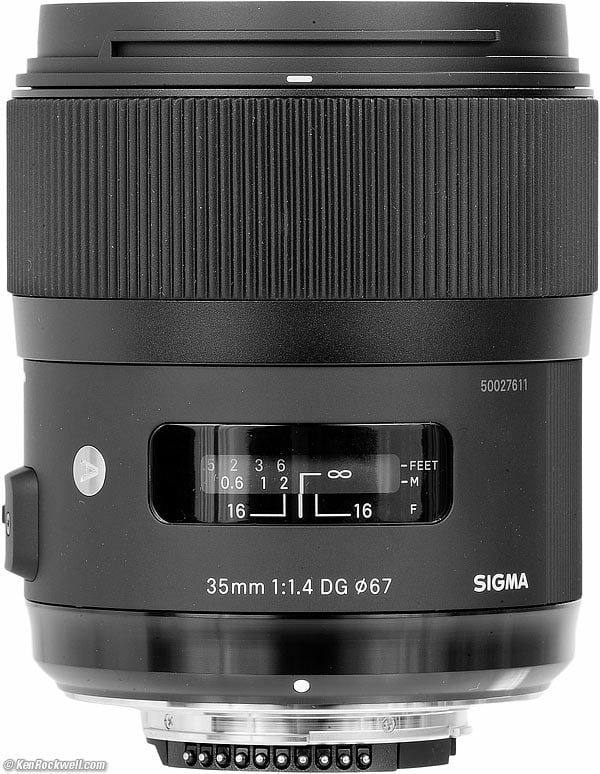
Sigma 35mm f/1.4 DG HSM.
Ergonomics are great; grab and go.
I find the mounting indices of the Nikon are too small and harder to find either by feel or by looking.
The footage scale is illegible; it's tiny and in dark gray. It's also usually covered by the plastic window, so I hope you prefer meters.
The plastic feels a little yuckier than the professional lenses, but otherwise, no surprises.
Falloff (darkened corners) performance top
Falloff on FX and 35mm is visible at f/1.4, and goes away at f/2 and smaller.
It's not likely to be an issue on DX (see crop factor).
No Nikon or Canon camera will have any data to correct this in-camera; you're on your own here.
I've devilishly exaggerated the falloff by shooting a gray field and placing these on a gray background:
Sigma 35mm f/1.4 DG HSM falloff on FX, Full-Frame and 35mm film at infinity, no correction.
© 2013 KenRockwell.com. All rights reserved.
|
Filters, use with performance top
There is no problem with vignetting, even with combinations of thick filters.
Even with three stacked 67mm filters (15mm total thickness excluding rear threads), there was only the slightest vignetting on full-frame, and then only at infinity
Any vignetting becomes slightly less as focused more closely or at larger apertures.
On DX, you'll be able to stack many more filters. (see crop factor.)
The filter ring never moves.
Focus Breathing performance top
Of interest mostly to cinematographers focusing back and forth between two subjects, the image from the Sigma 35mm f/1.4 DG HSM gets bigger as focused more closely.
Ghosts performance top
Ghost resistance is good, but not perfect. Ghosts won't be a problem unless you go looking to cause them:
Shot into the sun at f/8. bigger.
If we shoot directly into the daytime sun and lighten the image by two stops to make the ghosts more visible, we can get this:
Shot into the sun at f/16 to get a sunstar, and adding +2 stops exposure compensation to show the ghosts in the shadows. bigger.
But what you don't realize is that the sunshine required to do this is so bright that I can't look at it while doing this.
Don't worry, ghosts aren't a problem unless you go out of your way as I did to conjure them.
Hood performance top
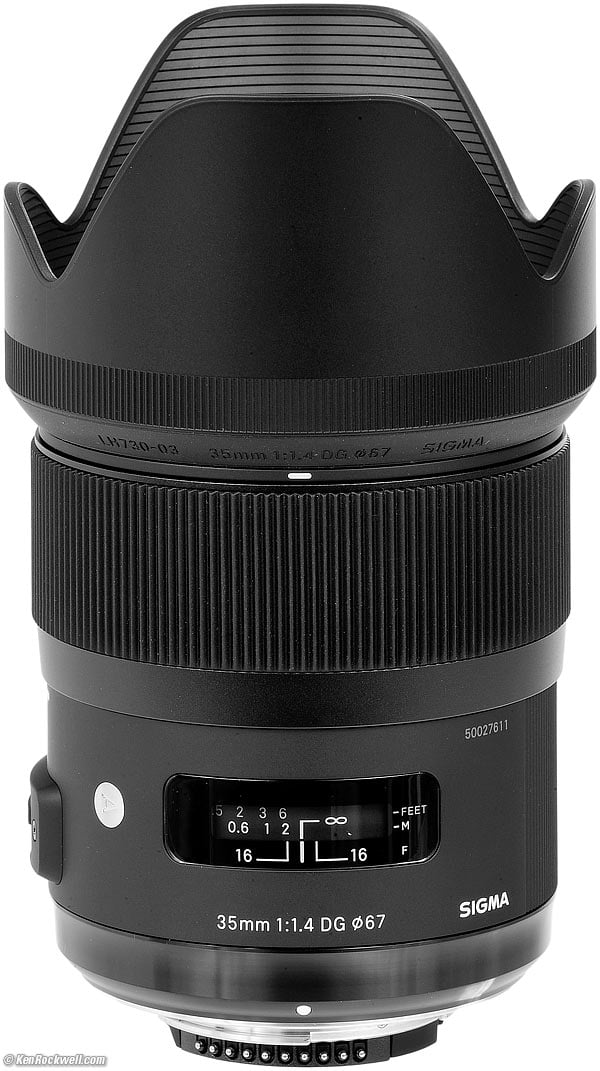
Sigma 35mm f/1.4 DG HSM with hood.
The hood is included.
I never use hoods; they're for sissies. Hoods haven't been needed since lenses became coated — in the 1950s!
Lateral Color Fringes performance top
There are no lateral color fringes as shot on my Nikon D800E, which corrects them automatically.
Nikons need no lens data to correct this; they can do it with any random lens.
I have not tested this on Canon, which would not be able to correct it without a lens profile, which does not exist.
Macro performance top
Macro isn't really. It gets to within a foot:
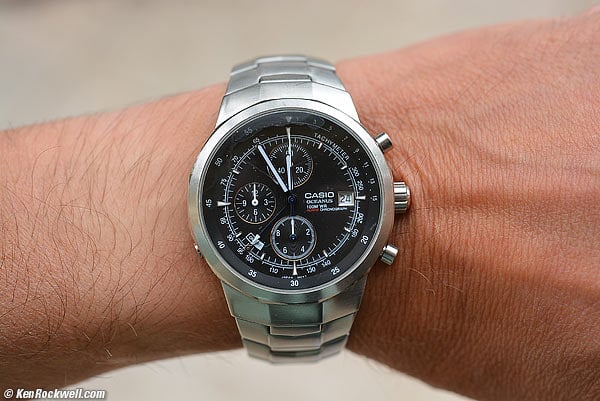
DX image at close-focus distance.
I've done Sigma a favor by showing this as shot on a DX camera. On full-frame, it won't seem as close (see crop factor).
Mechanics and Construction performance top
Sigma 35mm f/1.4 DG HSM. enlarge.
The Sigma 35mm f/1.4 DG HSM is built to typical amateur standards.
Filter Threads
Plastic.
Hood
Plastic bayonet.
Hood Mount
Plastic.
Focus Ring
Metal; rubber covered.
Depth-of-Field Scale
Two tiny ticks for f/16 and that's it; this doesn't really count.
Mid-Barrel Exterior
Plastic.
Very back of barrel
Metal.
Aperture Ring
None.
Mount
Shiny chromed brass.
Markings
Paint.
Mounting Index Dot
White plastic ball on the outside, and a red dot in the lens mounting flange.
Identity Plate
None, simply printed on lens barrel.
Serial Number
Laser engraved onto the lens barrel above and the right of the focus scale window.
Moisture seal at mount
None.
Noises When Shaken
Clunking from the diaphragm and focus systems.
Made in
Japan.
Weaknesses
as an off-brand lens it has unproven (with me) service facilities, and unknown future parts availability. When the HSM motor dies, you're dead unless you can get a replacement part.
New cameras may or may not work with this lens, and off-brand lens makers only sometimes will update lenses to work on new model cameras.
Sharpness performance top
Warning 1: Image sharpness depends more on you than your lens.
Warning 2: Lens sharpness doesn't mean much to good photographers.
Amateurs waste too much time worrying about lens sharpness, and since this lens is designed for amateurs, it's super sharp.
I tested this randomly purchased sample on a 36MP full-frame Nikon D800E on the test range at infinity:
At f/1.4
It's super sharp and contrasty in the center and most of the image, which is spectacular and as good as the Canon EF 35mm f/1.4 L and Nikon 35mm f/1.4 G.
The top and bottom are a little less well resolved, not that you'll ever notice it in prints less than 3 feet (1 meter) wide.
Corners are a little softer. You'll see it looking at images enlarged by 50 times (36MP seen on screen at 100% with a typical 100 DPI computer monitor), but only barely on 16 x 24" (50 x 75 cm) prints.
At f/2
The center is great, even a little better than at f/1.4.
The top and bottom are better than at f/1.4.
The corners are about the same as at f/1.4, just lighter since falloff is less prevalent.
At f/2.8
The center is perfect.
The corners are better. They'll look pretty good even on 30 x 40 inch (90 x 140 cm) prints.
At f/4
The corners are even better, looking great even on 30 x 40 inch (90 x 140 cm) prints.
At f/5.6
The corners are better, looking pretty good on 4 x 6 foot (1.4 x 1.8 meter) prints.
At f/8
The corners are optimum at f/8, looking great on 4 x 6 foot (1.4 x 1.8 meter) prints.
f/8 is the optimum aperture overall.
At f/11
Diffraction makes it slightly less sharp than at f/8.
At f/16
Diffraction makes it slightly less sharp than at f/11.
Sharpness Summary
For actual photography, the Sigma 35mm f/1.4 is sharper than any consumer is likely to be able to appreciate. Even shot at f/1.4, it's super sharp, and in real photos, the corners aren't ever in focus — they only are at my test range where everything is at infinity throughout the entire frame.
I bought this one from Adorama so I know it hasn't been fiddled with. Never buy at retail since Sigma does not seal their packages, and you'll never know who has monkeyed with your lens before you bought it.
Spherochromatism performance top
Spherochromatism, sometimes mistakenly called "color bokeh" by laymen, is a minor aberration which can add slight color fringes to out-of focus highlights in very fast lenses.
I didn't see any in actual shooting, but if I go out of my way to show it, it's got the usual amount expected in a lens like this. Out-of-focus highlights behind the subject can take on slight green fringes, and those in front could take on slight magenta fringes.
Complete DX image at f/1.4.
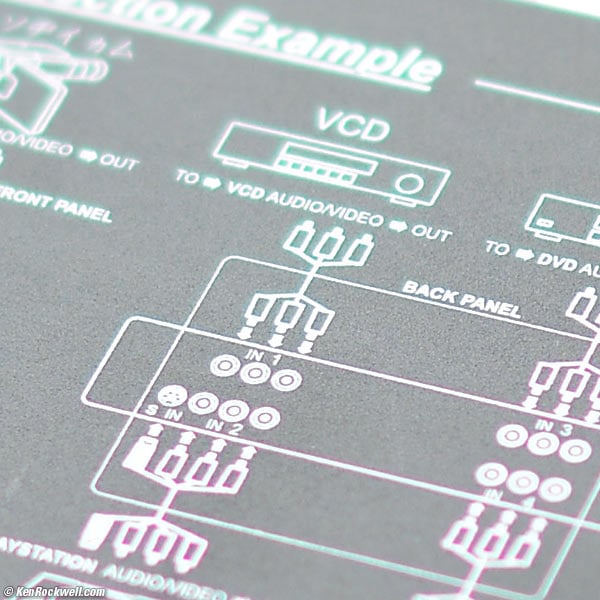
Crop from center of above 13MP DX image at 100%.
Sunstars performance top
With its rounded diaphragm, the Sigma 35 14 rarely makes any sunstars on brilliant points of light.
If you really push it, it can do this at f/16; but it took me a while to get this:

Sigma 35mm f/1.4 sunstar at f/16.
Compared top
Intro Specifications Performance Compared Recommendations More
I've been making comparisons throughout this entire review. Here are merely some tabulations of specifications.
Versus Nikon
| Introduced | 2012 |
2010 |
1970 |
1989 |
2009 |
| Actual focal length | 36.0mm |
36.0mm |
|||
| Filter | 67mm |
67mm |
52mm |
52mm |
52mm |
| Filter | plastic |
plastic |
Metal |
plastic |
plastic |
| Barrel | plastic |
plastic |
Metal |
plastic |
plastic |
| Mount | Metal |
Metal |
Metal |
Metal |
Metal |
| OK on manual-focus cameras? | no |
no |
Yes |
Yes |
Yes |
| OK on DSLRs? | usually |
Yes |
Yes |
Yes |
Yes |
| Optics | 13/11 ASPH |
10/9 ASPH |
9/7 CRC |
6/5 |
8/6 |
| Diaphragm Blades | 9 rounded |
9 rounded |
9 |
7 |
7 rounded |
| f/minimum | 16 |
16 |
16 |
22 |
22 |
| Focus | AF-S/USM/HSM |
AF-S |
Manual |
AF-D |
AF-S |
| Instant manual-focus override? | Yes |
Yes |
Yes |
no |
Yes |
| Focus Scale | Yes |
Yes |
Yes |
Yes |
no |
| Depth-of-field scale | not really |
not really |
Yes |
Yes |
no |
| Infra-red index | no |
no |
Yes |
Yes |
no |
| Close Focus | 0.3m |
0.3m |
0.3m |
0.25m |
0.3m |
| Maximum Repro Ratio | 1:5.2 |
1:5 |
1:5.5 |
1:4.2 |
1:6.1 |
| Weight | 661g |
600g |
381g |
200g |
197g |
| Price, 12/2010 | |||||
| Price, 4/2013 |
Versus Canon
| Anni | 2012 |
1998- |
2012- |
1990- |
2012 |
| Filter Threads | 67mm |
72mm |
67mm |
52mm |
82mm |
| Filter Threads | plastic |
Metal |
plastic |
plastic |
plastic |
| Barrel | Mostly plastic |
Metal and plastic |
Plastic |
Plastic |
Plastic and metal |
| Build Feel | Consumer |
Pro |
Good Consumer |
Good Consumer |
Tough Consumer |
| Autofocus motor | USM/HSM |
USM |
USM |
Arc-Form Drive |
USM |
| Instant Manual Override? | Yes |
Yes |
Yes |
No |
Yes |
| Close Focus | 1' 0.3m |
1' 0.3m |
0.8' 0.24m |
0.8' 0.25m |
1.25' 0.38m |
| Maximum Repro Ratio | 1:5.2 |
1:5.5 |
1:4.3 |
1:4.76 |
|
| Sharpness | Excellent |
Excellent |
Excellent |
Excellent |
Excellent |
| Diaphragm | 9 rounded |
8 blades |
8 blades |
5 blades |
9 blades |
| Sunstars | few |
8 points |
8 points |
10 points |
18 points |
| f/minimum | f/16 |
f/22 |
f/22 |
f/22 |
|
| Distortion @ 3m | +0.3 |
+1 |
+1.2 |
+1.1 |
|
| Bokeh | |||||
| Length | 94mm |
86mm |
63mm |
42mm |
123mm |
| Diameter | 77mm |
79mm |
78mm |
67mm |
83mm |
| Weight | 23.3 oz. 661 g |
20.5 oz. 582 g |
11.9 oz. 336 g |
7.4 oz. |
28.4 oz. |
| Price, 12/2012 | |||||
| Price, 4/2013 |
* add to cart for this price.
Recommendations top
Intro Specifications Performance Compared Recommendations More
This Sigma 35/1.4 has superb optics, but in an iffy mechanical package.
I wouldn't buy a Sigma lens because I don't trust their lens' long-term viability (I demand that any lens I buy serve me for about 20 years), but if you can get over my personal problems, this consumer-grade Sigma 35mm f/1.4 DG HSM has the same superb optics as Nikon or Canon's professional lenses.
Deployment
Sigma uses crappy caps. Leave them in the box for resale, and buy the real Nikon or Canon caps to use with this lens instead.
I would also leave the hood in the box for resale time. I don't use them.
I'd leave either a 67mm Nikon Clear (NC - UV) filter, or a 67mm Hoya Super HMC UV on the lens at all times.
If I was working in nasty, dirty areas, I'd forget the cap, and use an uncoated 67mm Tiffen UV filter instead. Uncoated filters are much easier to clean, but more prone to ghosting.
For color slides like Velvia 50, I use a 67mm Hoya HMC 81A outdoors.
For B&W film outdoors, I'd use a 67mm Hoya HMC K2 Yellow or 67mm Hoya HMC Orange.
If you now have or ever expect to have any 77mm -threaded pro lenses, the smartest thing to do is to get a 67mm -> 77mm step-up ring, and treat this lens as a 77mm-threaded lens from now to eternity. This will save you a lot of aggravation, unless you really do build a system around 67mm filters.
If you step-up to 77mm filters as I suggest, be sure to get a new 77mm Nikon front cap, and then use:
I'd leave either a 77mm Nikon Clear (NC - UV) filter, or a 77mm Hoya Super HMC UV on the lens at all times.
If I was working in nasty, dirty areas, I'd forget the cap, and use an uncoated 77mm Tiffen UV filter instead.
For color slides like Velvia 50, I use a 77mm Hoya HMC 81A or 77mm Nikon A2 filter outdoors.
For B&W film outdoors, I'd use a 77mm Hoya HMC Yellow K2 or 77mm Hoya HMC Orange.
If 82mm-threaded lenses are in your future (my Canon 24-70mm f/2.8 L II and 16-35mm f/2.8 L II use 82mm filters), then step up from 67mm to 82mm, and use 82mm filters.
More Information top
Intro Specifications Performance Compared Recommendations More
Help me help you top
I support my growing family through this website, as crazy as it might seem.
The biggest help is when you use any of these links when you get anything, regardless of the country in which you live. It costs you nothing, and is this site's, and thus my family's, biggest source of support. These places have the best prices and service, which is why I've used them since before this website existed. I recommend them all personally.
If you find this page as helpful as a book you might have had to buy or a workshop you may have had to take, feel free to help me continue helping everyone.
If you've gotten your gear through one of my links or helped otherwise, you're family. It's great people like you who allow me to keep adding to this site full-time. Thanks!
If you haven't helped yet, please do, and consider helping me with a gift of $5.00.
As this page is copyrighted and formally registered, it is unlawful to make copies, especially in the form of printouts for personal use. If you wish to make a printout for personal use, you are granted one-time permission only if you PayPal me $5.00 per printout or part thereof. Thank you!
Thanks for reading!
Mr. & Mrs. Ken Rockwell, Ryan and Katie.
Home Donate New Search Gallery Reviews How-To Books Links Workshops About Contact

